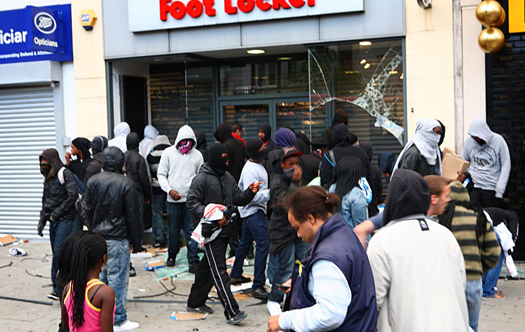
Photo by Hozinja used under a Creative Commons licence
The riots that ripped through English cities during four days in August were more ferocious and catastrophic than similar outbursts in the recent past. They have caused a prolonged and unprecedented bout of soul searching amongst all strands of British society. How could this happen? What caused it? Who is to blame?
Blame has been heaped mainly on the cuts-obsessed, expenses-fiddling politicians; the Metropolitan Police who inadvertently triggered the rioting by shooting a man in the street; the nation’s under-funded education system; and city councils who rushed to close youth centres in the wake of the global economic crises.
Opprobrium has also been directed at the parents of rioters (special venom is reserved for single mothers — the great bogey figures of the British right wing press); role models in entertainment and sport; the despised and greedy bankers; even British rappers have had accusatory fingers pointed at them.
One group has so far escaped blame: designers. Hardly surprising — who could possibly think that we mild mannered individuals are somehow responsible for murder, theft, arson and civil disobedience on an apocalyptic scale? And yet, a salient feature of these riots has been the fact that the main target of the attacks has been the shops of the major retail brands of British commercial life.
In previous modern-day riots, the aim has been to expose grievances relating to social injustice. And although the young of multicultural urban Britain have many genuine social grievances, on this occasion they made their objective the acquisition of free stuff.
The principal target was a highly successful chain of shops called JD Sports. It sells fashionable street wear. Other popular targets included mobile phone shops, electrical goods stores, and outlets of leading UK fashion brands.
All these shops spend huge amounts of money on branding, on store layout, on window displays, and slick advertising. Their ads leap at us from newspapers, magazines, TV, radio, and the Internet. Celebrities endorse their products. They are little shrines of desire.
Despite one or two gleefully publicised cases, the majority of the rioters came from poor homes in the least desirable, least well-resourced areas of England’s major cities. They come from places with low achievement rates in education, and where employment prospects are low.
These young people are not poor in the sense in which we understand poverty in the undeveloped world. They have Blackberrys (the encrypted Blackberry messaging system was used extensively to coordinate attacks), fashionable jeans, and cool footwear: but they are poor enough to have a sense of being excluded from the great orgy of consumer acquisitiveness that is flaunted in front of them daily.
Specifically, they are excluded from the world of desire and consumption created by the brand owners, advertising agencies, art directors, graphic designers, photographers, product designers, retail designers, architects, stylists, retouchers, and copywriters.
I’m not advocating a puritan revolution. I don't want to ban advertising, or return to the bad design that characterised British shops in the 1970s — they were brown, musty, and unwelcoming. Nor do I think a single designer has ever gone to work thinking “Today I must create something that drives the underprivileged youth of modern Britain mad with desire and envy.”
But for the past three or four decades the major role of graphic design has been to create the branding and collateral of desire. For those who can afford entry into this world — no harm is done. For those who can resist the blandishments of this world — no harm is done. But for those who have neither the education nor emotional maturity to deal with this, immense harm is done.
Some designers have been warning about the unwanted side-effects of the design revolution, most notably Ken Garland. As far back as 1964, he launched his First Things First manifesto; and more recently, designers such as Jonathan Barnbrook and the supporters of Adbusters have issued similar caveats.
These warnings are often mocked as “idealistic” and “naive.” But from now on, it's going to be hard for critics to dismiss them. There really is a price to pay for creating the seductive tropes of modern commerce. We’ve seen what happens when you create a beautifully manicured world of desire, and then say to a big chunk of the population, no entry. Seductive design is emphatically not the main cause of the riots, but it is a contributing factor, and we’d be dishonest to deny our part in it.
What is to be done?
Interestingly, for some time now, I’ve watched the emergence of a generation of design students and young designers who don't want to become the agents of commercial seduction. They are looking for a new role — one where social value is the new capital, not the sales charts of brand owners. Suddenly, they seem like the only acceptable future for design.
This essay was originally published in August, 2011. It is included in our anothology Culture is Not Always Popular: Fifteen Years of Design Observer out this fall from MIT Press.
